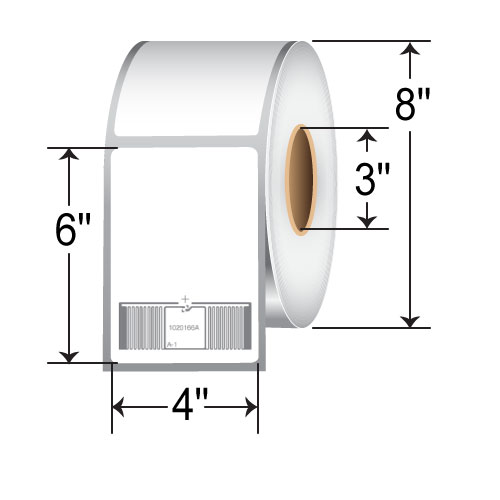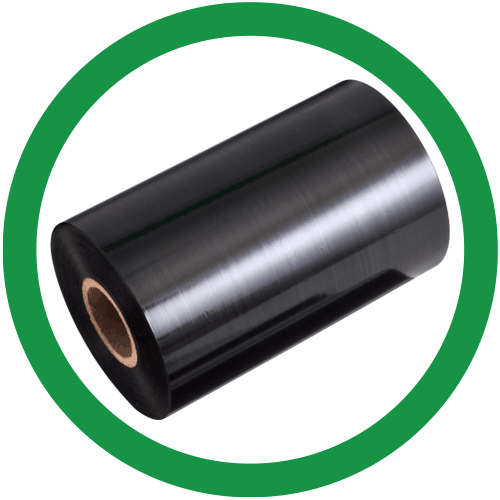

Printronix 4x6 Thermal Transfer RFID Label
| Print Technology | Thermal Transfer |
| Width (inches) | 4.00 inch |
| Length (inches) | 6.00 inch |
| Core Size | 3.00 inch |
| Format Type | Roll |
| Adhesive Type | Permanent |
| RFID Frequency | UHF |
| Perforation | Perforated |
| Style | Durable |
| Color | White |
| Order Quantity | Per Roll |
| Synthetic Material | Other |
Product Highlights
Div, Refer to RF-400600-8-03, Media 105, Thermal Transfer 4.0 inch x 6.0 inch, 500/Rl, Boingtech 359,1RLS/Carton

Printronix Auto ID RFID Labels
A thermal transfer RFID paper label with a permanent adhesive. This is is suitable for apparel chain management applications, including the labeling of corrugate and plastic packaging materials. These labels can also be used for close coupling.
What is RFID and How Does it Work?
Radio requency identification, RFID, uses radio waves to automatically identify objects. Item data is stored on a microchip attached to an antenna, (called an "RFID transponder" or "RFID tag"). The tag transmits the data to a reader with it passes within range, and the reader can convert the signal to digital information that can be used by a computer for further processing.
RFID Technology
RFID has become an established technology for applications such as tracking goods through the supply chain and managing inventory in retail stores. In such applications, RFID not only provides unique serialization of case, pallet, or item level goods, but also enables faster read rates than other technologies such as barcodes. A typical RFID label is similar to a typical pressure sensitive label but with a UHF RFID transponder (or inlay) embedded between the facestock and release liner. In a basic application, the RFID inlay within the label is encoded with a serialized number using a printer-encoder, such as the Printronix Auto ID T6000e, T4000 or T800 RFID printers. The label is simultaneously printed like a regular barcode label. Unlike barcodes, RFID data can be accessed without the visibility of the tag itself, and multiple RFID smart labels can be read quickly. Printronix Auto ID RFID printer-encoders support dozens of RFID inlays, including those from mainstream manufacturers such as Alien Technology, Avery Dennison (including Smartrac), BoingTech and Tageos. For a complete listing of tested inlays, please visit our website at https://printronixautoid.com/rfid-solutions/.
Performance Guarantee
All Printronix Genuine Supplies RFID labels are guaranteed to provide optimal performance with all Printronix Auto ID RFID printers, having been certified in our RFID Tag and Label Validation lab.
With access to a huge array of inlays and face sheet materials, we can support almost any custom RFID label construction, including validating performance on the target Printronix Auto ID RFID printer. Fill out our “RFID Label Specification Worksheet” and our experienced quoting team will get back to you with a quote.
RFID Label Specifications:
- Chip-neutral insertion process - compatible with available UHF (915MHz) or HF (13.56 MHz) transponders
- Insertion in a variety of materials, TTR, films, tag, and synthetic tag
- Specialty adhesives available
- Pre-encoding and imprinting available
- Press speeds up to 500 feet per minute
- Delivered 100% verified
- DOD-Compliant Label Service Bureau
- Alien Squiggle and Avery AD224 are trademarks of their respective manufacturers
How will RFID help my Business?
Radio frequency identification, or RFID, has many benefits:- Improved accuracy of tracking prduct and loction in the warehouse.
- Reduce manual hand scanning saving labor costs
- Retail shops can manually scan inventory in minutes not hours.
- Unlike barcodes RFID chips can hold multiple fields of information.
- RFID chips can be embedded in plastic for greater durability.
- Warehouse deliveries can be scanned by simply entering the dock.
- Retail shops can reduce product theft substantially.
- Hospitals can increase secutiry of assets and patients.
RFID Important Basics for Chips Inlays and Tags
The metal electronic chip that can be embedded into plastic, label material or other weather proof devices are called Chips, Inlays or Tags.
These chips are basically data collection devices that hold a lot more inforamtion than a typical barcode. Putting information onto the chip is called "Encoding". Special RFID printers can Encode or wrote the information onto the RFID chip. You may also purchase RFID chips with your information already encoded or pre-encoded.
RFID Chips have two basic parts
1. A Microchip - for stroring data
2. An Antenna - for radio wave Reception or Transmission


